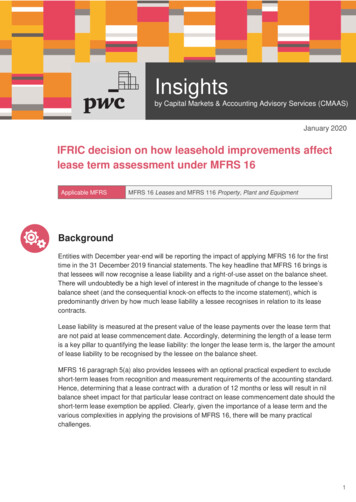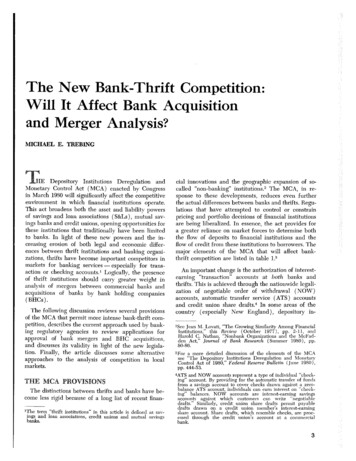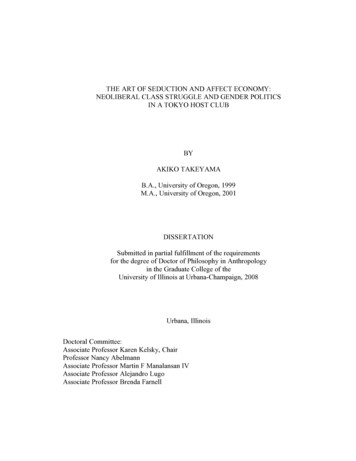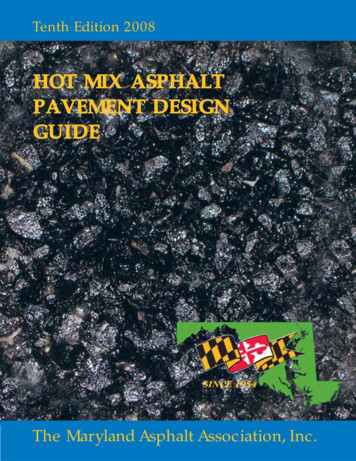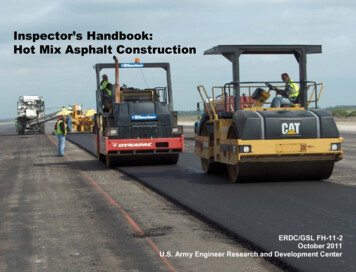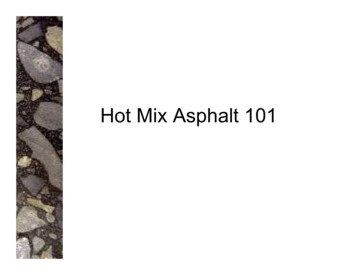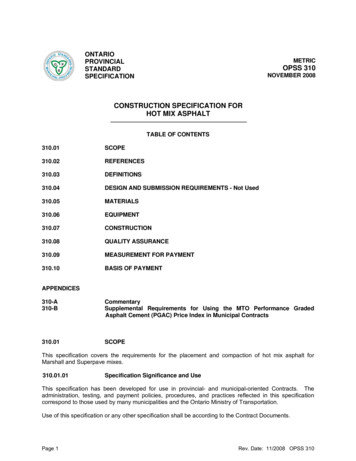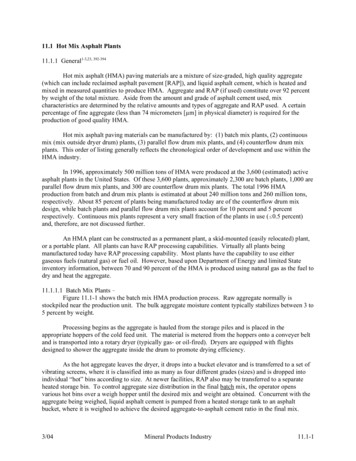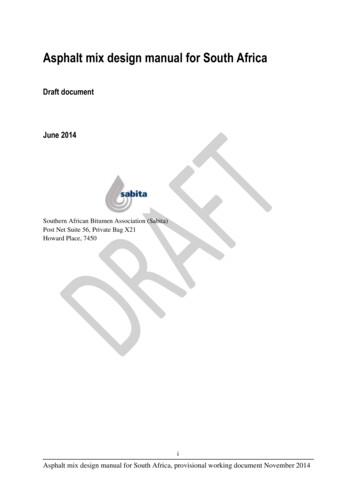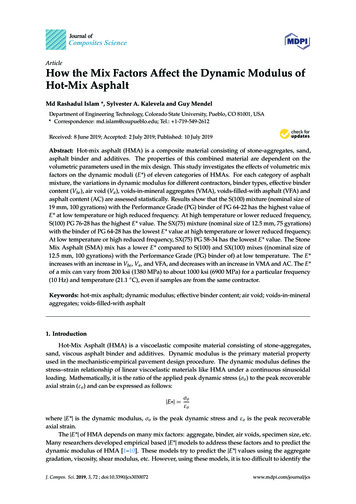
Transcription
ArticleHow the Mix Factors Affect the Dynamic Modulus ofHot-Mix AsphaltMd Rashadul Islam *, Sylvester A. Kalevela and Guy MendelDepartment of Engineering Technology, Colorado State University, Pueblo, CO 81001, USA* Correspondence: md.islam@csupueblo.edu; Tel.: 1-719-549-2612Received: 8 June 2019; Accepted: 2 July 2019; Published: 10 July 2019 Abstract: Hot-mix asphalt (HMA) is a composite material consisting of stone-aggregates, sand,asphalt binder and additives. The properties of this combined material are dependent on thevolumetric parameters used in the mix design. This study investigates the effects of volumetric mixfactors on the dynamic moduli (E*) of eleven categories of HMAs. For each category of asphaltmixture, the variations in dynamic modulus for different contractors, binder types, effective bindercontent (Vbe ), air void (Va ), voids-in-mineral aggregates (VMA), voids-filled-with asphalt (VFA) andasphalt content (AC) are assessed statistically. Results show that the S(100) mixture (nominal size of19 mm, 100 gyrations) with the Performance Grade (PG) binder of PG 64-22 has the highest value ofE* at low temperature or high reduced frequency. At high temperature or lower reduced frequency,S(100) PG 76-28 has the highest E* value. The SX(75) mixture (nominal size of 12.5 mm, 75 gyrations)with the binder of PG 64-28 has the lowest E* value at high temperature or lower reduced frequency.At low temperature or high reduced frequency, SX(75) PG 58-34 has the lowest E* value. The StoneMix Asphalt (SMA) mix has a lower E* compared to S(100) and SX(100) mixes ((nominal size of12.5 mm, 100 gyrations) with the Performance Grade (PG) binder of) at low temperature. The E*increases with an increase in Vbe , Va , and VFA, and decreases with an increase in VMA and AC. The E*of a mix can vary from 200 ksi (1380 MPa) to about 1000 ksi (6900 MPa) for a particular frequency(10 Hz) and temperature (21.1 C), even if samples are from the same contractor.Keywords: hot-mix asphalt; dynamic modulus; effective binder content; air void; voids-in-mineralaggregates; voids-filled-with asphalt1. IntroductionHot-Mix Asphalt (HMA) is a viscoelastic composite material consisting of stone-aggregates,sand, viscous asphalt binder and additives. Dynamic modulus is the primary material propertyused in the mechanistic-empirical pavement design procedure. The dynamic modulus defines thestress–strain relationship of linear viscoelastic materials like HMA under a continuous sinusoidalloading. Mathematically, it is the ratio of the applied peak dynamic stress (σo ) to the peak recoverableaxial strain (εo ) and can be expressed as follows: E σoεowhere E* is the dynamic modulus, σo is the peak dynamic stress and εo is the peak recoverableaxial strain.The E* of HMA depends on many mix factors: aggregate, binder, air voids, specimen size, etc.Many researchers developed empirical based E* models to address these factors and to predict thedynamic modulus of HMA [1–10]. These models try to predict the E* values using the aggregategradation, viscosity, shear modulus, etc. However, using these models, it is too difficult to identify theJ. Compos. Sci. 2019, 3, 72 ; doi:10.3390/jcs3030072www.mdpi.com/journal/jcs
J. Compos. Sci. 2019, 3, 722 of 9sensitivity of E* for different mix factors. In fact, not all the volumetric mix factors are included inthese models. Several studies tried to find out the effects of different mix factors on the E* values.For example, Robinette and Williams [11] examined the effects of sawing or coring on the dynamicmodulus of asphalt concrete and concluded that the two factors do not affect the dynamic modulussignificantly. Tandon et al. [12] evaluated the effect of height-to-diameter ratio on the dynamic modulusof asphalt concrete and found that specimens with a diameter of 152 mm instead of the standard102 mm provided more consistent results. Shah et al. [13] measured the dynamic modulus on elevenmixes and reported that it was sensitive to binder content.However, none of the studies investigated the sensitivity of E* to different mix factors suchas voids in mineral aggregates (VMA), void-filled with asphalt (VFA), effective binder content (Vbe ),contractors, mix gradation, and binder types at a time to have a comprehensive understanding.This study is thus motivated to study these factors at a time. Therefore, the main objectives of thisresearch are:1. To analyze the effects of VMA, VFA, Vbe , AC, contractors, mix gradation, and binder types onthe E* of asphalt concrete.2. To determine the most economic and durable Hot-Mix Asphalt (HMA) mixtures for hightemperature for pavement design based on the E* comparison.Asphalt content (AC) is the percent of the total amount of asphalt binder used in the mix withrespect to the total mix by weight. Air void (Va ) is the percent of total volume of air in the mixcompared to the bulk volume of the compacted mixture. The intergranular space occupied by asphaltand air in a compacted asphalt mixture is known as VMA. The VFA is the percentage of voids in thecompacted aggregate mass that are filled with asphalt cement. The total asphalt binder content of themix that is coated on the aggregate surface (deducting any absorbed binder) is called the effectiveasphalt content (Vbe ).2. MaterialsEleven different types of asphalt mixes were studied in this research. These are listed in Table 1.Two different nominal maximum aggregate sizes (NMASs) of 0.75 in. (19 mm) and 0.50 in. (12.5 mm)of aggregates and two different numbers of gyrations (100 and 75) were used in the mix design.Different types of performance grade (PG) binders were used. The abbreviations used to represent themixes are listed below: The letter ‘S’ means the NMAS of 0.75 in. (19 mm).The letter ‘SX’ means the NMAS of 0.5 in. (12.5 mm).The numbers in the parenthesis such as 75 and 100 are the numbers of gyrations used in themix design.The first numbers in the PG binder such as 58 and 64, are the average seven-day maximumpavement temperature ( C)The second numbers in the PG binder such as 22 or 28 are the minimum pavement designtemperature likely to be experienced ( C).Thus, a S(100) PG 64-22 means a mix with the NMAS of 0.75 in. (19 mm) and a binder of PG 64-22meaning the average seven-day maximum pavement temperature is 64 C and the expected minimumpavement temperature is 22 C.All the specimens are collected from real field coring. The mixtures were produced by thecontractors in their plants.
J. Compos. Sci. 2019, 3, 723 of 9Table 1. Eleven mixtures used in this study.Mix IDNMAS, in. (mm)BinderNumber of GyrationsS(100) PG 64-22S(100) PG 76-28SMA PG 76-28SX(75) PG 58-28SX(75) PG 58-34SX(75) PG 64-22SX(75) PG 64-28SX(100) PG 58-28SX(100) PG 64-22SX(100) PG 64-28SX(100) PG 76-280.75 (19)0.75 (19)0.50 (12.5)0.50 (12.5)0.50 (12.5)0.50 (12.5)0.50 (12.5)0.50 (12.5)0.50 (12.5)0.50 (12.5)0.50 (12.5)PG 64-22PG 76-28PG 76-28PG 58-28PG 58-34PG 64-22PG 64-28PG 58-28PG 64-22PG 64-28PG 76-28100100100757575751001001001003. Dynamic Modulus (E*) TestingThe E* testing on collected real field cores is conducted by CDOT’s Asphalt Material Unit usingAASHTO TP 62 [14] test protocol and the Asphalt Mixture Performance Tester (AMPT) testing device.The diameter of the cores collected from the sites is 150 mm. The 50-mm diameter and 110-mm inheight cores were cut horizontally out of the collected field cores. According to the AASHTO TP62 procedure, samples of 4-in. (100-mm) diameter and 6-in. (150-mm) height are prepared in thelaboratory or field cores are collected. Then, using the AMPT testing device, sinusoidal compressionloading is applied uniaxially at three different temperatures of 4 C, 20 C, and 40 C. The testingfrequencies are 0.1 Hz, 1 Hz, and 10 Hz at each temperature with the exception that another (4th)frequency of 0.01 Hz is adopted for 40 C.4. Analysis of the Effects of Mix Factors on the Dynamic ModulusRutting is caused during hot seasons. At high temperature, asphalt becomes soft and its modulusdecreases. Then, asphalt material deforms easily after applying load. Therefore, a mixture is verysusceptible to rutting if it has less modulus at high temperature and vice-versa. Bottom-up or top-downfatigue cracking is dependent not only on the modulus but also other parameters. To find out whichmix is good for rutting and transverse cracking, a group-wise comparison is made here. The averageof the fitted parameters from each group has been chosen and plotted together as shown in Figures 1and 2 to compare among the groups. More clearly, the model was applied separately on each specimenand then the means of the model parameters were calculated. The model used is MasterSolver todetermine the master curve of a dynamic modulus using the following equation:log E log(Min) log(Max) log(Min)1 eβ γlogωrwhere: E dynamic modulusωr reduced frequency, HzMax limiting maximum modulus, ksiMin limiting minimum modulus, ksiβ and γ fitting parametersThe reduced frequency is computed using the Arrhenius equation given below:log(ωr ) logω where: 1 Ea1 19.14714 T Tr
J. Compos. Sci. 2019, 3, 724 of 9ωr reduced frequency at the reference temperatureω loading frequency at the test temperatureTr reference temperature, KCompos. Sci. 2018, 2, xT J.testtemperature, K Ea J. Compos.activationenergy(treated as a fitting parameter)Sci. 2018,2, x5 of 105 of 1025000SX(75) SX(75)SX(75)PG58-28PG58-3420000SX(100)SX(75) )PGPG64-2264-2215000SX(100)SX(75) PG X(75) PG 76-28PG 76-285000SMA 76-2800000101000Reduced Frequency (Hz)00101000Reduced Frequency (Hz)Figure 1. Groupwise comparison in a semi-log graph.0100000100000Figure 1. Groupwise comparison in a semi-log graph.Figure 1. Groupwise comparison in a semi-log )(MPa)10000SX(75) X(75) PGPG64-2264-22100SX(100)SX(75) PG 64-22100SX(75)PGPG64-28SX(100)64-22SX(100)SX(75) PG PG 76-2811000000000110100Reduced Frequency (Hz)0110100SMA 76-28100010000100010000100000 1000000100000 1000000ReducedFrequencyFigure 2. Groupwisecomparisonin a(Hz)log–log graph.Figure 2. Groupwise comparison in a log–log graph.FigureGroupwisecomparisonin a log–logFigures 1 and 2 show thatthe2.E*value variesgreatly amongstthegraph.different binders. For example,at 10 Hz of loading, the E* of SX(75) PG 64-28 mix is about 600 ksi (4150 MPa), whereas the S(100) PGFigures 1 and 2 show that the E* value varies greatly amongst the different binders. For example,64-22 mix has a value of 1200 ksi (8300 MPa) (an increase of 100%). It is also apparent that the S(100)at 10 Hz of loading, the E* of SX(75) PG 64-28 mix is about 600 ksi (4150 MPa), whereas the S(100) PG64-22 mix has a value of 1200 ksi (8300 MPa) (an increase of 100%). It is also apparent that the S(100)
J. Compos. Sci. 2019, 3, 725 of 9The combination of the above two equations gives the following:log E log(Min) log(Max) log(Min) Ea111 eβ γ(logω 19.14714 ( T Tr ))The shift factors for each temperature are given by the following equation:log[a(T )] Ea11 19.14714 T Trwhere:a(T) shift factor at temperature TThe maximum limiting modulus is estimated from mixture volumetric properties using the Hrischmodel shown below, and a limiting binder modulus of 1 GPa: VMAxVFA1 PcVMA 435, 000 VMA E max Pc 4, 200, 000 1 10010, 000(1 100 )VFA 4,200,000435,000VFAwhere: 435,000VFA 0.58VMA 0.58 650 435,000VFAVMA Pc 20 E max limiting maximum dynamic modulus, psiVMA voids in mineral aggregates, %VFA voids filled with asphalt, %The model was applied separately to each specimen and then the means of the model parameterswere calculated and plotted in Figures 1 and 2.Figures 1 and 2 show that the E* value varies greatly amongst the different binders. For example,at 10 Hz of loading, the E* of SX(75) PG 64-28 mix is about 600 ksi (4150 MPa), whereas the S(100)PG 64-22 mix has a value of 1200 ksi (8300 MPa) (an increase of 100%). It is also apparent that theS(100) PG 64-22 mixture has the highest value of E*, especially at low temperature or high reducedfrequency. Thus, the S(100) PG 64-22 mix has the greatest potential for the transverse cracking. At hightemperature or lower reduced frequency, the S(100) PG 76-28 mix has the highest E* value and is thebest mix for minimal rutting. The SX(75) PG 64-28 mix has the lowest E* value at high temperature orlower reduced frequency. At low temperature or high reduced frequency, the SX(75) PG 58-34 mix hasthe lowest E* value. The average fitted SMA mix has a lower E* value compared to the S(100) andSX(100) mixes at low temperature, and thus, would likely have lower predicted transverse crackingthan S(100) and SX(100) mixes. A summary of the analysis’ finding for the most durable and worstmixes for rutting is presented in Table 2.Table 2. Summary of the most durable and worst mixes for rutting.Mix TypePropertyCommentsS(100) PG 76-28SX(75) PG 64-28Highest at high temperatureLowest at high temperatureBest mix for ruttingWorst for ruttingTransverse cracking is caused during winter seasons. At low temperature, asphalt contractsdue to decrease in temperature. Then, thermal stress is developed. If the developed thermal stressexceeds the capacity of the mix, transverse cracking occurs. Therefore, it is expected that a mixtureis very susceptible to transverse cracking if it has high modulus at low temperature and vice-versa.
J. Compos. Sci. 2019, 3, 726 of 9In this study, the S(100) PG 64-22 mixture has the highest value of E*, especially at low temperature orhigh reduced frequency. Thus, t
Hot-Mix Asphalt (HMA) is a viscoelastic composite material consisting of stone-aggregates, sand, viscous asphalt binder and additives. Dynamic modulus is the primary material property used in the mechanistic-empirical pavement design procedure. The dynamic modulus defines the stress–strain relationship of linear viscoelastic materials like HMA under a continuous sinusoidal loading .
